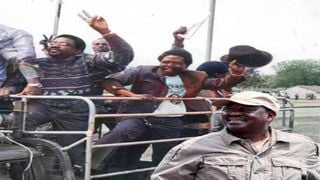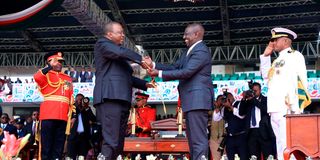
Opposition leaders heading to Kamukunji Grounds July 7, 1990. (inset) Azimio leader Raila Odinga.
| File | Nation Media GroupPolitics
Premium
Inside Kenya’s politics where betrayal is the nature of the game
What you need to know:
- Kenya’s political script is replete with scenes of deceit and betrayal – with many a politician often breaking agreements and throwing their close allies under the bus to protect their own interests. From our founding fathers to the current crop of leaders, playing dirty and nasty is the nature of the game.
If former United Kingdom politician Henry John Temple’s words that “we have no eternal allies, and we have no perpetual enemies.
Our interests are eternal and perpetual, and those interests it is our duty to follow”, are anything to go by, then they can be said to be a true reflection of Kenyan political leaders.
Though he was talking about foreign policy and diplomacy, Kenya’s political script has been that of deceit and betrayal, with politicians throwing their close allies under the bus, and ‘moving on swiftly’.
From unfulfilled campaign promises, to Memoranda of Understanding (MoUs) rejected and thrown out the window once elections are over, all summed up by betrayal of allies who help their associates up the political ladder, the writing is clear in Kenya’s political history.
This dates back to the 1960s when the country’s founding President Mzee Jomo Kenyatta fell out with his first deputy Jaramogi Oginga Odinga barely two years into office, to second president Daniel Arap Moi who failed to endorse his long serving Vice-President George Saitoti in 2002.
It proceeded to third president Mwai Kibaki who reneged on an MoU with Raila Odinga, who was to be named Prime Minister after the 2002 elections, and all through to former president Uhuru Kenyatta who had a bitter falling out with his deputy William Ruto, who is now President.
For Kenya, the politics of betrayal begun when Oginga Odinga resigned as vice president in 1966 and started the Kenya People’s Union (KPU).
The latter formation of Forum for the Restoration of Democracy Kenya (Ford-K) was a sure bet that the Kanu regime was on its way out with President Moi preparing for a titanic battle in 1992 election.
Oginga Odinga, Phillip Gachoka, Ahmed Bahmariz, Martin Shikuku, George Nthenge and Masinde Muliro ganged up in old age to spearhead a youthful people-driven agenda to cause the repeal of section 2A that declared Kenya a dejure one party state.
The resolve was palpable within and without the Kenyan borders. However, a cunning President Moi mastered the art of divide and rule.
Secretary-General Martin Shikuku sneaked to State House where he joked that he just went to eat ugali.
That move scuttled the dreams of Kenyans as Ford-K was split into two (Ford-K and Ford Asili) as the old guard followed Matiba while the Young Turks remained in Ford Kenya with Oginga.
Muliro died of heart complications at JKIA on return from an overseas trip hence the western grip remained with Shikuku.
Former Vice-President Mwai Kibaki also formed Democratic Party (DP) in a move that was a betrayal of its own kind that eventually split the populous Kikuyu vote, denying Matiba victory in the 1992 poll.
Liberals like George Anyona, Prof Mukaru Ng’ang’a and Dr Chibule wa Tsuma formed fringe parties that ate into the opposition vote block.
It’s a ghost that was slayed in Saba Saba — the anti-Moi rally held on July 7, 1990 and which Azimio leader Raila Odinga wants to re-enact today — which forced Moi to repeal section 2A in 1991.
The death of Jaramogi in 1994 also saw his son, Mr Odinga, turn against former VP Michael Kijana Wamalwa who had been touted as his possible successor.
Even though Wamalwa won the battle for control of Ford-K, Mr Odinga led a section of the party, mainly from Nyanza region, to form National Development Party (NDP) on whose ticket he contested for the presidency in the 1997 elections.
Prof Gitile Naituli of Multimedia University opines that Kenya generally has a problem of teamwork among leaders.
“It’s driven by primitive jealousies which block thinking capacity. This is not only being encountered among the country’s top leadership, but also among governors and their deputies,” Prof Naituli says.
He adds that some leaders are not able to appreciate those below them who wield bigger potential, citing the case of Mzee Kenyatta and Jaramogi, Moi with Kibaki and Saitoti as his deputies as well as former President Kenyatta and his successor Dr Ruto with whom they fell out ahead of last year’s election.
Political analyst Dismas Mokua agrees, saying failure to respect political commitments has been the recipe for moments of political instability in the country.

President William Ruto receives the instruments of power from his predecessor Uhuru Kenyatta after taking the oath of office at Kasarani International Stadium on September 13, 2022. Mr Kenyatta supported Azimio leader Raila Odinga in the August elections, betraying their initial deal with Dr Ruto.
He says that a number of Kenyan politicians have abandoned civility to the extent that their word counts for nothing, and embraced politics marked by deceit and propaganda.
“It is the case that it is impossible to legislate morality. Parties who want to engage in mischief ab initio can always enter into contracts and assault. In the past, parties have propaganda as insurance,” he says.
In the run-up to 2002 elections, Mr Odinga would team up with then President Moi with the hope of succeeding him in that year’s election, agreeing to dissolve his NDP party to join Kanu.
At the March 18, 2002 event that oversaw the Kanu-NDP merger, Mr Odinga was named Secretary-General of New Kanu, and Uhuru Kenyatta, Kalonzo Musyoka, Musalia Mudavadi and Katana Ngala chosen as the four vice-chairmen.
Moi would later settle on Mr Kenyatta as his successor leading to a mass walkout from Kanu, with Mr Odinga leading the troops, including Saitoti, to form Liberal Democratic Party (LDP) which later joined forces with Kibaki, Wamalwa and Charity Ngilu of National Alliance of Kenya (NAK) to form National Alliance Rainbow Coalition (Narc) that stopped Mr Kenyatta’s possible ascension to power.
Mr Odinga reportedly reached out to Ford People candidate Simeon Nyachae and, according to the late former minister, Mr Odinga promised to back his bid but went ahead to declare “Kibaki Tosha” at a rally in Uhuru Park, which introduced Kibaki as the compromise Opposition presidential candidate in 2002.
But Mr Odinga’s goose was to be cooked immediately after the election, when Kibaki reneged on a deal to name him Prime Minister, despite Mr Odinga having carried the team after the captain (Mr Kibaki) was seriously injured just weeks to the elections.
Kibaki’s personal physician, Dr Dan Gikonyo had even underscored Mr Odinga’s role in ensuring the then opposition candidate was flown to London for treatment.
The string of betrayal continued, with Mr Odinga in 2005 leading more than half of the Cabinet to reject a new Constitution proposed by President Kibaki’s team, a move the latter responded to by firing the entire Cabinet.
Mr Odinga used the win in the referendum—which used the orange symbol for No—to form the Orange Democratic Movement (ODM) which catapulted him to a close election, and which led to the country’s bloodiest and deadliest post-election violence, with 1,000 dead and 600,000 displaced.
Mr Kenyatta who together with Mr Musyoka were members of the ‘No’ camp, however, joined Kibaki’s re-election campaign, with Mr Musyoka coming in right after the disputed poll, and bagging the VP slot.
Mr Musyoka had fallen out with Mr Odinga in the run up to the 2007 election, and through his ally, now Makueni Senator Dan Maanzo, took off with the ODM-K certificate leaving Mr Odinga and his team including President Ruto, Mr Mudavadi, former ministers Najib Balala, Charity Ngilu and Joseph Nyaga exposed, forcing them to acquire ODM party from Lawyer Mugambi Imanyara.
Through former United Nations Secretary-General Kofi Annan-negotiated deal, Mr Odinga would be named Prime Minister in 2008, with Mr Kenyatta who had joined forces with Kibaki in the previous poll being one of Mr Odinga’s co-deputies alongside Mr Mudavadi.
Mr Ruto, who also played a key role in Mr Odinga’s ascension to the higher office would also later fall out with Mr Odinga in the run up to the 2013 elections, which forced Mr Musyoka and his team to troop back to Mr Odinga’s camp after it became apparent that he was not going to win Kibaki’s support for the top seat.
Mr Kenyatta and Mr Ruto had already teamed up and had won Kibaki’s support, even though some government operatives are said to have had a soft spot for Mr Mudavadi as Kibaki’s successor.
Mr Musyoka supported Mr Odinga and was named his running mate in the 2013 election under Coalition for Reforms and Democracy (Cord), a position he retained in the 2017 election under National Super Alliance (Nasa).
In 2022, another betrayal happened.
Mr Kenyatta betrayed his deputy, Dr Ruto, instead choosing to side with Mr Odinga.
While Mr Musyoka, who had even tabled a secret 2017 pact with Mr Odinga that the ODM leader would back his bid in 2022 opted to back him for a third consecutive time through Azimio la Umoja One Kenya Coalition, Mr Mudavadi and Mr Wetang’ula joined forces with Dr Ruto in the Kenya Kwanza Alliance that saw them triumph over the Kalonzo-Raila camp.
Mr Kenyatta had crisscrossed the country promising to go for two terms and back Dr Ruto for another 10 years. “It is better to support a honest person who will protect the country and its resources instead of backing an individual who will only look at himself,” Mr Kenyatta said in one of his speeches as he denounced Dr Ruto.
But Embakasi East MP Babu Owino still insists that Mr Kenyatta “conned” Mr Odinga as he was in a position to aide his victory, insisting that there was no way a “State candidate” could lose an election by only 200,000 votes.
“I believe it was a long con,” Mr Owino said during an interview on Citizen TV.
Mr Odinga, however, insists that Mr Kenyatta backed his bid because of his track record but ensured a level playing field in last year’s election. “He did not even use the security forces. He did not give instruction to the police, the intelligence machinery, the DCI to support me in any way. The environment was very free and fair for everybody,” the ODM leader said during an interview on Citizen TV last December.
But even as Mr Kenyatta backed Mr Odinga, he faced a serious rebellion from his Mt Kenya backyard which stuck with Dr Ruto, promising to pay his political debt.
Even Mr Kenyatta’s close allies like Attorney-General Justin Muturi and Council of Governors Chairperson Anne Waiguru, dumped him at his hour of need and rallied behind Dr Ruto, his estranged deputy.
Mr Kenyatta is also facing a rebellion from nominated MP Sabina Chege and her East Africa Legislative Assembly (Eala) counterpart Kanini Kega who are wresting the Jubilee party from him.
Mr Odinga is also facing betrayal from his close allies, some of whom he ensured were elected in his backyard and who have since moved to Dr Ruto’s side.





